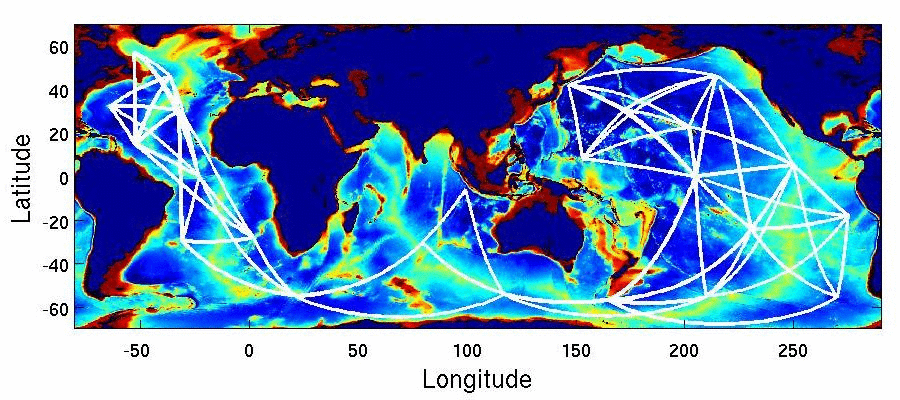
Brian Dushaw
dushaw@apl.washington.edu
Applied Physics Laboratory
University of Washington
1013 N.E. 40th Street
Seattle, WA 98105-6698
Popular version of paper 3pID4
"Building the oceanic concert hall: Multidisciplinary applications of acoustics for ocean observing systems"
Presented Wednesday afternoon, May 25, 2011
161st ASA Meeting, Seattle, Washington.
There are very few ways in which the world's oceans can be observed, measured, or monitored. One obvious way is to put an instrument within the ocean to measure temperature, currents, nutrients, etc. in the vicinity of the instrument. Such measurements are, of course, purely local measurements, hence there are usually not enough of them to adequately measure the enormous, turbulent ocean. For all of the history of oceanographic science to date, the oceans have been perennially under sampled. Another way to observe the ocean is to fly satellites around the Earth employing radar or other such remote sensing techniques that measure only the topmost layer of the oceans. The ocean is an electrical conductor made of seawater, so that radar and other such techniques do not measure the ocean to any depth. Unlike radar, sound travels through the ocean's very efficiently, hence acoustical approaches to ocean observation are naturally appealing. Many critters of the seas are aware of this property, and they employ sound to great effect for a variety of purposes. Sound is a natural part of the life of sea creatures ranging from blue whales to snapping shrimp. The sea creature known as the oceanographer has heretofore only used sound in the ocean sporadically and as a novice, however.
Over the past decade, the oceanographic community has been constructing observational systems to serve the immediate and long-term needs of the society (www.ioos.gov). These systems include physical, biological, chemical and geological components to obtain a comprehensive understanding of the state of the oceans. For the past several decades, governments have provided considerable tax-payer dollars to support basic research in the oceanographic sciences. The fruits of this investment in research are only now beginning to yield a return. The overarching goal of the "ocean observing system" is to provide practical products and information to society as a return on its long-term investment in oceanographic research. Demand is increasing for information about the state of our oceans to address a myriad of issues ranging from climate variability to fisheries management to public education. Customers for ocean observing systems range from government agencies to commercial shipping companies to the science projects of high school students. Two developing “observing systems” in the Pacific Northwest are the Northwest Association of Networked Ocean Observing Systems (www.nanoos.org) and the Neptune Undersea Cable Network (www.interactiveoceans.washington.edu). Just as designing and building a new concert hall draws on the results of years of research on a wide-variety of acoustical topics to obtain a concert hall with honed acoustical properties that concert-goers can enjoy for years and years, the ocean observing system is drawing on the results of years of ocean research to build a system that can serve societies need for environmental information over the coming decades and centuries.
Since the oceans are largely transparent to sound, oceanographic, biological, and signal-processing acoustic techniques are primary tools for ocean observation, engineering, and monitoring. These tools range from local systems to track and count fish populations to acoustic thermometry using acoustic transmissions across ocean basins to acoustic modem systems for relaying information from the seafloor to a surface buoy for transmission back to shore by satellite communications. The opportunities and value of long-term acoustical observations and techniques within these systems are boundless, yet incorporation of these techniques has been opportunistic and ad hoc. As the ocean observing system is being developed, the acoustical applications have yet to receive the attention and implementation that is warranted, partly out of funding issues and partly out of simple inattention from oceanographers and acousticians. Coordination of the acoustical applications is essential to ensure that these many applications, which often share simple, common infrastructure needs such as hydrophones, power, and communications, are developed to reach their full potential. Advocates of acoustical techniques for the ocean observing system face enormous challenges of planning, implementation, and data management to bring acoustical tools to fruition for ocean observing systems.
But this process is still at its infancy.
One possible application for acoustics at the global scale is given in Figure 1. This figure shows acoustic paths from a modest number of low-frequency acoustic sources installed at carefully selected regions over the globe to receivers similarly located over the globe. These long paths are possible because of the very efficient acoustic propagation of low-frequency sounds. These sources would perhaps be cabled to shore for their power and communications needs. Regular acoustic signals from these sources would serve two purposes. First, the travel times of acoustic pulses sent over these paths could be used for measuring the ocean's temperature. It has been shown that such measurements are possible, are robust, and are a unique measure of large-scale ocean temperature not possible by other means. Second, such acoustic transmissions would accurately locate any of the subsurface, autonomous oceanographic devices that are presently used for ocean observation. The ability to locate such subsurface devices is not yet possible. In addition to the acoustic sources, a larger number of passive acoustic listening systems would be installed, with quite modest power and maintenance requirements.
These receivers would record the acoustic transmissions and at the same time monitor such things as marine mammal calls, the evolution of manmade sounds over decades, and detecting the occasional but regular geophysical events. There are no practical or environmental impediments to deploying such a system at this time.
[http://909ers.apl.washington.edu/~dushaw/anim_global.gif]
